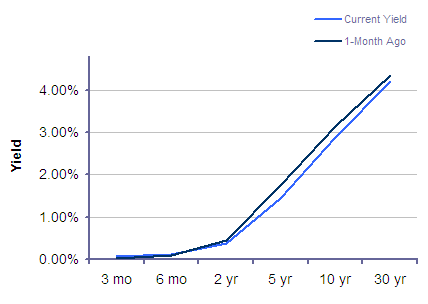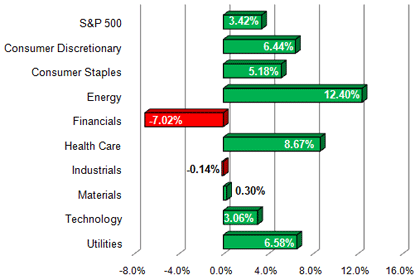
Market Commentary by Scott J. Brown, Ph.D., Chief Economist

For some time, financial market participants have been complacent about the federal debt ceiling being raised. After all, we’ve been here before and when push comes to shove, lawmakers will raise the debt ceiling because they have to raise the debt ceiling. The consequences of not doing so would be catastrophic for the economy and the financial markets. However, as we near the August 2 deadline, both parties remain far apart, raising the possibility that the ceiling might not be raised in time. Already, investors have pulled out of money market funds (opting instead for FDIC-backed bank deposits). Banks have begun to raise capital and tighten credit on consumer and business borrowers – none of this is good for economic growth.
The economic data remained generally disappointing. The advance estimate of Q211 GDP growth came in at a 1.3% annual rate (vs. a median forecast of +1.8%), with consumer spending at a 0.1% pace (held back by higher gasoline prices and a drop in motor vehicle sales). More troublesome, benchmark revisions delivered downward adjustments to GDP figures for Q410 and Q111.
Business fixed investment was moderate and defense spending rebounded from a sharp drop in Q111 (as expected). State and local government subtracted 0.4 percentage points from GDP growth. Nondefense federal spending subtracted 0.2 percentage point. In other words, fiscal policy has been contractionary (and yet, some people want to cut more).
Next week, the debt ceiling will be the main focus. August 2 is the drop dead date. The most likely scenario is that we’ll see an agreement in time. While the odds of not raising the debt ceiling are still seen as relatively low, the economic and financial consequences would be severe. The economic calendar includes a number of important data releases. The ISM Manufacturing Index has market-moving potential (provided we get a surprise), but Friday’s payroll figure will carry much more weight. Payrolls are expected to have advanced at a subpar-but-moderate pace in July, with help from a seasonal quirk in autos, but with a further drag from state and local government.
Indices
| Last | Last Week | YTD return % | |
| DJIA | 12240.11 | 12724.41 | 5.72% |
| NASDAQ | 2766.25 | 2834.43 | 4.27% |
| S&P 500 | 1300.67 | 1343.80 | 3.42% |
| MSCI EAFE | 1684.27 | 1704.67 | 1.57% |
| Russell 2000 | 799.34 | 841.26 | 2.00% |
Consumer Money Rates
| Last | 1-year ago | |
| Prime Rate | 3.25 | 3.25 |
| Fed Funds | 0.11 | 0.20 |
| 30-year mortgage | 4.51 | 4.60 |
Currencies
| Last | 1-year ago | |
| Dollars per British Pound | 1.637 | 1.560 |
| Dollars per Euro | 1.433 | 1.300 |
| Japanese Yen per Dollar | 77.670 | 87.470 |
| Canadian Dollars per Dollar | 0.949 | 1.039 |
| Mexican Peso per Dollar | 11.711 | 12.716 |
Commodities
| Last | 1-year ago | |
| Crude Oil | 97.44 | 76.99 |
| Gold | 1615.95 | 1163.10 |
Bond Rates
| Last | 1-month ago | |
| 2-year treasury | 0.39 | 0.45 |
| 10-year treasury | 2.89 | 3.14 |
| 10-year municipal (TEY) | 4.22 | 4.25 |
Treasury Yield Curve – 7/29/2011
S&P Sector Performance (YTD) – 7/29/2011
Economic Calendar
| August 1st |
— |
Construction Spending (June) ISM Manufacturing Index (July) |
| August 2nd |
— |
Personal Income and Spending (June) Motor Vehicle Sales (July) |
| August 3rd |
— |
Challenger Layoffs (July) ADP Payroll Estimate (July) ISM Non-Manufacturing Index (July) |
| August 4th |
— |
Jobless Claims (week ending July 30th) Productivity (Q211, preliminary) |
| August 5th |
— |
Employment Report (July) |
| August 9th |
— |
FOMC Meeting (no press conference) |
| August 12th |
— |
Retail Sales (July) |
Important Disclosures
Past performance is not a guarantee of future results. There are special risks involved with global investing related to market and currency fluctuations, economic and political instability, and different financial accounting standards. The above material has been obtained from sources considered reliable, but we do not guarantee that it is accurate or complete. There is no assurance that any trends mentioned will continue in the future. While interest on municipal bonds is generally exempt from federal income tax, it may be subject to the federal alternative minimum tax, state or local taxes. In addition, certain municipal bonds (such as Build America Bonds) are issued without a federal tax exemption, which subjects the related interest income to federal income tax. Investing involves risk and investors may incur a profit or a loss.
US government bonds and treasury bills are guaranteed by the US government and, if held to maturity, offer a fixed rate of return and guaranteed principal value. US government bonds are issued and guaranteed as to the timely payment of principal and interest by the federal government. Treasury bills are certificates reflecting short-term (less than one year) obligations of the US government.
Commodities trading is generally considered speculative because of the significant potential for investment loss. Markets for commodities are likely to be volatile and there may be sharp price fluctuations even during periods when prices overall are rising. Specific sector investing can be subject to different and greater risks than more diversified investments.
Tax Equiv Muni yields (TEY) assume a 35% tax rate on triple-A rated, tax-exempt insured revenue bonds.
![]() Material prepared by Raymond James for use by its financial advisors.
Material prepared by Raymond James for use by its financial advisors.
The information contained herein has been obtained from sources considered reliable, but we do not guarantee that the foregoing material is accurate or complete. Data source: Bloomberg, as of close of business July 21st, 2011.
©2011 Raymond James Financial Services, Inc. member FINRA / SIPC.




